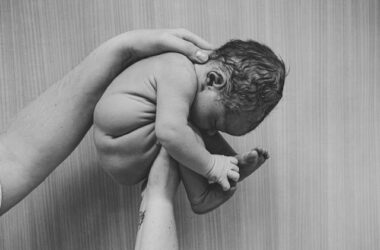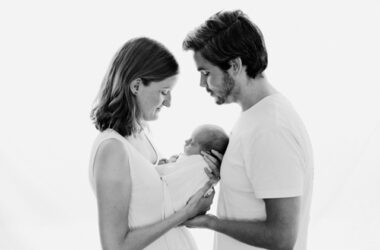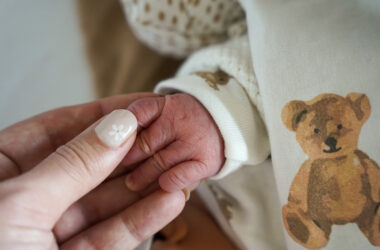From Despair to Determination: How I Faced My Daughter’s CDH Diagnosis
My name is Lanisha and I’m a 24-year-old single mother of a girl named Leyoncé (2 1/2 years). My daughter was born with a rare disorder called Congenital Diaphragmatic Hernia, abbreviated as CDH, which means a hole in her diaphragm. She has left-sided CDH. Her heart was shifted to the right, her liver was next to her heart and part of her intestine and spleen was in her chest cavity. She also had a twisted stomach. Because of the opening in her diaphragm, her left lung was unable to develop properly, resulting in a small lung. Just like that, I was thrown off cloud nine after getting this news.
Pregnancy: how did I find out?
In December 2020, I found myself holding a positive pregnancy test. I was so happy! I couldn’t wait until the first ultrasound. I had my first ultrasound in January, everything looked fine and I could already see a beating heart. In February, I had an ultrasound to determine my due date and, once again, everything looked great except that the baby had a large stomach. The midwife said, “She must be eating well with such a full stomach!” At the end of February, the ultrasound showed that I was expecting a little girl! I had a feeling it would be a girl since day one.
The 20-week ultrasound was scheduled for March when I was 18 weeks pregnant. This is always an exciting ultrasound, of course, because it’s an anatomy scan. Even though you assume your child is healthy, it’s still an exciting moment. The sonographer was almost done with the ultrasound and everything looked fine. Until the last moment, when it suddenly became very quiet. She said that the baby’s stomach was quite large and that her heart was shifted. She referred me directly to the academic hospital for a more detailed ultrasound to determine possible birth defects. Luckily, I could get an appointment the next day. At the hospital, they confirmed that she had left-sided CDH. And just like that, I was thrown off cloud nine!
Discover and stimulate your baby's mental development
Download now
Hospital check-ups
In the Netherlands, there are only two academic hospitals with a CDH expertise team: Amalia Children’s Hospital and Erasmus MC Sophia Children’s Hospital. I was treated at the Amalia Children’s Hospital. I had my first appointment in April, when they once again did a detailed ultrasound. This provided final confirmation that she had left-sided CDH. And I also learned which organs were in her chest cavity instead of her abdominal cavity. They told me that her liver was next to her heart, part of her intestine and spleen were in her chest cavity and that her left lung was too small and not developing properly. Children with CDH are put into different categories so that they know which protocol to follow during pregnancy, birth and afterwards.
My daughter had a 15-35% chance of survival. Because her left lung was so small, she was eligible for FETO treatment. This means that they place a small balloon via the womb in the baby’s trachea to allow the lungs to develop better. It was up to me whether or not I wanted this treatment to be performed. My maternal instinct told me that I should let nature take its course. I felt that her lung was better developed than they could see in the ultrasound. I also had the option to have an amniocentesis. The reason was that children with CDH often have other disorders or Down syndrome. Again, I relied on my maternal instinct and decided against it. After all, even if she had Down syndrome, I would love her just as much as if she didn’t. Until I was induced, I had a detailed ultrasound every two weeks at the Amalia Children’s Hospital.
I stayed positive throughout the pregnancy
During every check-up at the hospital, I stayed positive. And if I had any concerns, I could simply call my midwife for an extra ultrasound or to listen to the baby’s heart. This gave me peace of mind. Everyone around me kept saying: Lanisha, why did this have to happen to you? How can you stay so positive? My answer was: because she’s part of me. I can give her all the love, care and attention she needs. And because I can handle it.
I stayed strong the entire time. But every night in bed, the tears would stream down my face. I would hold onto my belly and say, “Stay with mama, you can do it.”
Induction and eventful birth
At 38 weeks pregnant, I was induced at the Amalia Children’s Hospital. I needed to give birth at that hospital so that they could immediately ‘save’ my daughter. On 10 August, I signed into the hospital in Nijmegen to be induced. On 12 August, my water broke. A few hours later, I experienced a storm of contractions and spent the entire time in the shower, but did not dilate more than 2 cm. In the afternoon, I asked for a gynaecologist because I could barely breathe due to all the contractions. At first, they thought that I was not yet in labour, but at 2:30 in the afternoon, they rushed my bed into the delivery room because I had definitely gone into labour! I was immediately given an epidural to get some rest. I was 9 cm dilated at 6:30 in the evening, but she had not dropped yet.
They did another ultrasound and could see that my daughter was a stargazer: her face was upward instead of downward.

At 8:30 pm, I was fully dilated, but she had still not dropped. At 10:30 pm, I had to push her into place. At 11:30 pm, they told me I could push one more time because otherwise they would need to perform an emergency caesarean because her heartbeat was starting to dip. At 11:36 pm, Leyoncé was born: I was so happy because I wanted a natural birth, which would be better for her lungs. She was lifeless, white and limp. I was happy, sad and scared all at the same time. All I could do was hope that she would make it. There were several doctors ready to immediately ‘save’ my daughter. She was put on a ventilator and given an IV for medicine, vitamins and minerals. She also had a tube in her mouth to keep her stomach empty until after surgery.
On ECMO, surgery and learning to drink
My daughter was put on an ECMO (heart-lung machine) because they believed she was in poor condition. Children with CHD are always appointed a personal ICU nurse to care for them. Luckily, the ECMO was not needed. On the fifth day after birth, 16 August, she underwent surgery. She had an intact membrane around her organs, so they could put everything back into place in her abdomen. This was very positive because not many children with this condition have this. She also had a twisted stomach, which the surgeon straightened out. The surgery was a success! One day three after the operation, I was allowed to give my daughter breastmilk through the catheter for the first time. This was a very special moment.
On 23 August, she was taken off the respirator: a huge milestone. On 28 August, she was allowed to drink a bottle of milk together with her mama. And put on clothes. On 31 August, we were transferred to the children’s ward, where we could practice bottle feeding and I could learn to use the feeding tube. A few days later, on 6 September, we were transferred to the regional hospital. And only two days later, on 8 September, we could go home! No one expected this to happen so quickly – within five weeks. At home, we continued practicing drinking from a bottle. If there was any milk left over because she did not have the energy to drink it, I gave it to her using a feeding tube pump. Within only one week, she no longer had to use a feeding tube and was able to drink everything from a bottle. This was extremely fast for a child with CDH.
How are things going now?
My daughter and I live with my parents. My mother has supported and helped me from the very first ultrasound. Leyoncé has an annual check-up with the CDH team at the Amalia Children’s Hospital and with the cardiologist, since she also has VSD and ASD, which are congenital heart defects. Leyoncé is now a happy 2 1/2-year-old toddler and is improving more and more. Even with all the medical issues, she is developing nicely. She is a very sweet, smart girl who loves to learn new things. Time after time, we are truly amazed by this little girl who refuses to give up. A real fighter!

For all moms
For all moms: always listen to your maternal instinct because it is (almost) always right. I’ve always listened to mine. And always done what feels right for me. And my daughter did and is doing so much better than expected. Our positive thoughts, motherly love, spending time with her in the ICU from early in the morning to late at night, touching Leyoncé, showing her affection and talking to her have given her the strength and love to be even stronger.
Lanisha, mother of Leyoncé.
Did this article help you?
Share this article
Receive a notification at the start of a leap!
Would you like to be prepared when your baby is about to enter a leap? Sign up for our leap alarm for free and always receive a notification when a leap is about to start!




